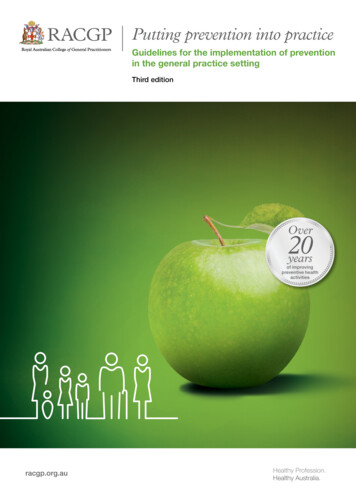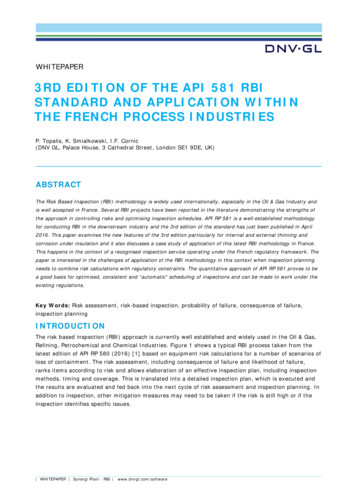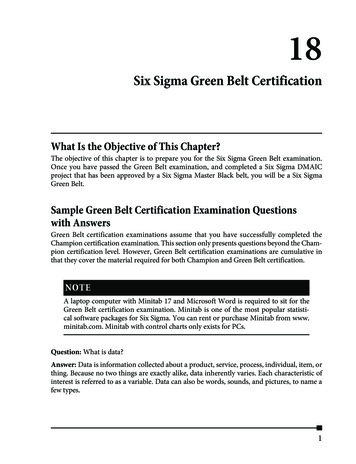
Transcription
Putting prevention into practiceGuidelines for the implementation of preventionin the general practice settingThird editionOver20yearsof improvingpreventive healthactivitiesracgp.org.auHealthy Profession.Healthy Australia.
Putting prevention into practice: Guidelines for the implementation of preventionin the general practice setting. Third editionDisclaimerThe information set out in this publication is current at the date of first publication and is intended for use asa guide of a general nature only and may or may not be relevant to particular patients or circumstances. Noris this publication exhaustive of the subject matter. Persons implementing any recommendations containedin this publication must exercise their own independent skill or judgement or seek appropriate professionaladvice relevant to their own particular circumstances when so doing. Compliance with any recommendationscannot of itself guarantee discharge of the duty of care owed to patients and others coming into contact withthe health professional and the premises from which the health professional operates.Accordingly, The Royal Australian College of General Practitioners Ltd (RACGP) and its employees andagents shall have no liability (including without limitation liability by reason of negligence) to any users of theinformation contained in this publication for any loss or damage (consequential or otherwise), cost or expenseincurred or arising by reason of any person using or relying on the information contained in this publicationand whether caused by reason of any error, negligent act, omission or misrepresentation in the information.Recommended citationThe Royal Australian College of General Practitioners. Putting prevention into practice: Guidelines for theimplementation of prevention in the general practice setting. 3rd edn. East Melbourne, Vic: RACGP, 2018.The Royal Australian College of General Practitioners Ltd100 Wellington ParadeEast Melbourne, Victoria 3002Tel 03 8699 0414Fax 03 8699 0400www.racgp.org.auABN: 34 000 223 807ISBN: 978-0-86906-493-1 (Print)ISBN: 978-0-86906-494-8 (Web)Published May 2018 The Royal Australian College of General Practitioners 2018This resource is provided under licence by the RACGP. Full terms are available at www.racgp.org.au/usage/licence. In summary, you must not edit or adapt it or use it for any commercial purposes. You mustacknowledge the RACGP as the owner.We acknowledge the Traditional Custodians of the lands and seas on which we work and live, and pay ourrespects to Elders, past, present and future.
Over20yearsof improvingpreventive healthactivitiesPutting prevention into practiceGuidelines for the implementation of preventionin the general practice settingThird edition
Putting prevention into practiceGuidelines for the implementation of prevention in the general practice setting. Third editionAcknowledgementsThe Royal Australian College of General Practitioners (RACGP) gratefully acknowledges the generous contributionof the following authors, contributors and reviewers of Putting prevention into practice: Guidelines for theimplementation of prevention in the general practice setting (Green Book), third edition.Green Book Editorial CommitteeProfessor Danielle MazzaChair, Green Book Editorial Committee; Head, Departmentof General Practice, Monash University; Conjoint Professor,School of Medicine and Public Health, University ofNewcastle, NSW; Fellow, Society of Family Planning, USA;RACGP Expert Committee – Quality CareMs Karen BoothPresident, Australian Primary Health Care NursesAssociationMs Jan ChaffeyChief Executive Officer, Camp Hill Healthcare, Qld;RACGP Expert Committee – eHealth and Practice SystemsScientia Professor Mark HarrisCentre for Primary Health Care and Equity, UNSWSydney; Centre for Obesity Management andPrevention Research Excellence in Primary Health Care(COMPaRE-PHC), NSW; RACGP Expert Committee –Quality CareAssociate Professor Charlotte HespeHead, General Practice and Primary Care Research,School of Medicine, University of Notre Dame; GeneralPractitioner, Glebe Family Medical Practice, NSW; VicePresident, RACGP; Chair, RACGP NSW&ACTDr Cory LeiGeneral practice registrar, Currambine Family Practice, WAAssociate Professor John LittDeputy Chair, RACGP Expert Committee – Quality CareMs Genevieve NolanPrograms Manager, MOVE muscle, bone & joint healthLtd, VicDr Raquel NewmanMedical Writer and Information Designer, SerumCommunications, VicContributorsDr Christine BoyceGeneral Practitioner, Hobart, TasMs Alice CreelmanCancer and Palliative Care Branch, Population Healthand Sport Division, Department of HealthProfessor Christopher Del MarFaculty of Health Science and Medicine, BondUniversity, QldDr Michael FasherGeneral Practitioner and Adjunct Associate Professor,University of SydneyDr Robert HoskingGeneral Practitioner, The Elms Family MedicalCentre, Vic; RACGP Expert Committee – eHealth andPractice SystemsMs Sally JarrettPractice Manager, Stirling Central Health Clinic, SADr Caroline JohnsonSenior Lecturer, Melbourne Medical School, Vic;RACGP Expert Committee – Quality CareDr Andrew KnightFairfield GP Unit, NSWMs Anne FritzPractice Manager, Kingston Family Practice,Brighton, SAMr Alessandro LuongoClinical QI Coordinator, South Western SydneyPrimary Health Network, NSWMs Kylie GibsonPractice Manager, Fisher and Holder FamilyPractice, ACTMs Fiona ThompsonClinical Services Manager, Pangula MannamurnaAboriginal Corporation, SADr Elizabeth HindmarshCo-author of the RACGP’s Abuse and violence: Workingwith our patients in general practice (White Book)Ms Lauren TraskAccreditation Specialist, Queensland Aboriginal andIslander Health Councili
iiPutting prevention into practiceGuidelines for the implementation of prevention in the general practice setting. Third editionConflicts of interestThis publication has been produced in accordance with the rules and processes outlined in the RACGP Conflict ofInterest (COI) Policy. The RACGP COI Policy is available at viewersWe gratefully acknowledge the expert reviewers and representatives from the organisations who contributedscholarly feedback.Chris AshSenior Project Officer, Gold Coas t Primary HealthNetwork, QldMs Beverley KornPrimary Health Care, Gold Coast Primary HealthNetwork, QldDr Donita BairdClinical Psychologist, VicDr Robbie LloydPort Macquarie Community College, NSWDr Melanie DorringtonBungendore Medical Centre, NSWProfessor Finlay MacraeHead, Colorectal Medicine and Genetics, RoyalMelbourne Hospital; Professor, Department of Medicine,University of Melbourne, Royal Melbourne HospitalDr Daniel EwaldLennox Head Medical Centre, NSWMs Felicia FletcherIntegrated Team Care Project Officer, Capital HealthNetwork, ACTDr Scott McKeownGeneral Practitioner and Public Health PhysicianAboriginal Health Service, TasDr Oliver FrankOakden Medical Centre, SA; RACGP ExpertCommittee – eHealth and Practice SystemsAssociate Professor Mark MorganAssociate Professor, Faculty of Health Sciencesand Medicine, Bond University; RACGP ExpertCommittee – Quality CareDr Brendan GoodgerPopulation Health and Chronic Disease Manager,Central and Eastern Sydney PHN, NSWDr Jeremy NunisOwen Terrace Medical Practice, SAProfessor Moyez JiwaWyndham Health Centre, Vic; RACGP ExpertCommittee – Standards for General PracticesDr Rosalie SchultzNgaanyatjarra Health Service, NTDr Sunita ThavarajadevaMawson Lakes Healthcare, SA
Putting prevention into practiceGuidelines for the implementation of prevention in the general practice setting. Third editionAcronyms and abbreviations5Asask, assess, advise/agree, assist, arrangeAPNAAustralian Primary Health CareNurses AssociationAUSDRISK Australian Type 2 Diabetes RiskAssessment ToolPRACTICE Principles, Receptivity, Ability and capacity,Coordination, Targeted, Iterative cycles,Collaboration, Effectiveness and efficiencyQIquality improvementQI&CPDQuality Improvement and ContinuingProfessional Development (Program)RACGPThe Royal Australian College ofGeneral PractitionersRE-AIMreach, effectiveness, adoption,implementation, maintenanceBMIbody mass indexCALDculturally and linguistically diverseCCFcongestive cardiac failureCISclinical information systemCISSComputer and information security standardsSIPService Incentive PaymentCMEclinical medical educationSMARTCOM-Bcapability, opportunity, motivation and behaviourSpecific, Measurable, Assignable, Realistic,Time-relatedCOPDchronic obstructive pulmonary diseaseSNAPsmoking, nutrition, alcohol, physical activityCPDcontinuing professional developmentTPBtheory of planned behaviourCVCCoordinated Veterans’ CareCVDcardiovascular diseaseDASSDepression, Anxiety and Stress ScaleDMAICdefine, measure, analyse, improve, controlEDemergency departmentEPCextended primary careFAVfamily abuse and violenceFOBTfaecal occult blood testGASPGPs Assisting Smokers ProgramGPgeneral practitionerHANDIHandbook of non-drug interventionsHbA1cglycated haemoglobinHHShyperosmotic hyperglycaemic syndromeITinformation technologyKTAknowledge-to-actionMBSMedicare Benefits ScheduleMImotivational interviewingNBCSPNational Bowel Cancer Screening ProgramNHSNational Health ServiceNPTnormalisation process theoryPDSAplan, do, study, actPHNPrimary Health NetworkPLANPlanning learning and needPNpractice nursePPIPPutting Prevention into Practice (program)iii
Putting prevention into practiceGuidelines for the implementation of prevention in the general practice setting. Third editionv1. ContentsAcknowledgementsGreen Book Editorial CommitteeContributorsConflicts of interestReviewersiiiiiiiAcronyms and abbreviationsiiiIntroduction11The Green Book1. Understanding the basics1.1 About prevention1.2 About implementation1.3 Bringing prevention and implementation together2. Whole-of-practice prevention2.1 Your practice population2.2 Your practice team2.3 Team collaboration3. Approaches to implementation3.1 Using an implementation framework to help you put prevention into practice3.2 An overview of the PRACTICE framework4. Putting prevention into practice4.1 Principles4.2 Receptivity (and engagement)4.3 Ability (and capacity)4.4 Coordination of people and processes4.5 Targeted to people and priorities4.6 Iterative cycles4.7 Collaborating to make it work4.8 Effectiveness (and efficiency)5. Setting up the practice for preventive care5.1 Managing patient information to support preventive care5.2 Creating an environment that supports preventionAppendix A. Frameworks to change patient behaviourA.1 The 5AsA.2 Motivational interviewingAppendix B. The COM-B modelThe COM-B modelAppendix C. Implementation frameworksC.1 The ‘plan, do, study, act’ cycleC.2 Knowledge-to-action frameworkC.3 The DMAIC 6767707072727375
viPutting prevention into practiceGuidelines for the implementation of prevention in the general practice setting. Third editionAppendix D. Case studies and stories presented in the Green Book77D1. Primary Health Network helping new owners of a practice77D2. Providing care to practice communities77D3. Working together to improve the health of Aboriginal and Torres Strait Islander peoples78D4. Using the Red Book with patients78D5. Risk factors in local practice population78D6. Improving immunisation rates79D7. Preventing childhood obesity79D8. Providing comprehensive care to Aboriginal and Torres Strait Islander peoples with chronic comorbities 80D9. Improving practice data for better health outcomes81D10. Improving weight by working together81D11. Wellness and weight groups in practice82D12. Change talk82D13. Use of facilitator to improve delivery of screening and prevention83D14. Improving care of patients with coronary artery disease83D15. GPs Assisting Smokers Program84D16. Collaborating to help patients with complex issues84D17. Targeting patient groups to improve bowel screening86D18. Using data to improve bowel screening87D19. Using data to improve your practice88D20. Using demographic data to improve care88D21. Modelling behaviour88FiguresFigure 1. How the Green Book fits with other RACGP publicationsFigure 2. The determinants of health and illnessFigure 3. Primary, secondary, tertiary and quaternary preventionFigure 4. Barriers and enablers of implementationFigure 5. Levels where interventions may be deliveredFigure 6. The QI teamFigure 7. Gantt chart in practiceFigure 8. Reality pyramid for smoking cessationFigure B1. The COM-B modelFigure C1. PDSA cycleFigure C2. The KTA process: ExampleFigure C3. The DMAIC model26791019394570727475TablesTable 1. Implementation theories and frameworksTable 2. PRACTICE componentsTable 3. Improving general practice engagement in preventive care deliveryTable 4. Effectiveness of implementation strategiesTable A1. The 5As2325334267BoxesBox 1. GuidelinesBox 2. Making the process more strategicBox 3. Reminders, recalls and promptsBox 4. Tips for setting up a high-quality website41416060
Putting prevention into practiceGuidelines for the implementation of prevention in the general practice setting. Third editionIntroductionFocusing on prevention is an important response to Australia’s increasing healthcare needs.In general practice, we are well trained and skilled in caring for, and working alongside, patients who present with multipleissues and health-related problems. What we don’t do often is step back from the individual before us and consider ourpatients as a community or population. Yet this shift in focus holds enormous potential to improve health outcomes. Whilewe continue supporting individuals to take greater responsibility for their health and prevent illness, if we also work at apractice population level, we have opportunities to affect the broader determinants of health and illness.Improving preventive care for individuals and communities leads to better health.1 To this end, multiple evidencebased recommendations have been developed. The Guidelines for preventive activities in general practice, ninthedition (Red Book) is a key source of these. However, when we look across general practice, implementation anddelivery of preventive services is variable.2,3It is not our medical knowledge that can adversely affect our ability to deliver preventive care. Rather, it is ourability to recognise and overcome a combination of individual factors (eg time pressures, competing demands,skill levels, attitudes) and practice systems and organisational factors (eg availability of a team, clarity of roles,lack of resources, a culture focusing on treatment rather than prevention). Putting preventive recommendationsinto practice requires knowledge in areas we are not well taught, such as implementation science, changemanagement, organisational behaviour, and data collection and analysis.In Putting prevention into practice: Guidelines for the implementation of prevention in the general practice setting(Green Book), we aim to give you enough useful knowledge in the above areas to create a clear and actionableplan to improve your practice’s preventive care.The Green BookSince 1998, The Royal Australian College of General Practitioners (RACGP) has published the Green Book tosupport evidence-based preventive activities in primary care.What is the Green Book?The Green Book is designed to help you put preventive care recommendations from best practice guidelines intopractice. It provides case studies to reflect on and contains advice about practical processes, strategies and toolsfor implementing and sustaining preventive activities.The Green Book brings together the evidence and the lessons learned from the literature and from real-life generalpractice experiences to make implementation of preventive activities as straightforward and effective as possible.These lessons include: Simply disseminating guidelines within your practice is not enough to change practice Using a practical framework that is guided by theory can improve success Implementing all recommendations from evidence-based guidelines may be unrealistic and unachievable – whatyou chose to implement depends on your practice context (ie established need, clinician preference, complexity,capacity/capability and resources available) Improving implementation depends on changing multiple behaviours of multiple people (ie healthcareprofessions, practice managers, administrators) Implementation efforts are more likely to be successful if you have strong organisational leadership and wholeof-practice engagement You need to set goals that you can measureBy aligning leadership, building capacity for change, creating a culture of quality improvement (QI), and selectivelychoosing the relevant processes needing change, general practices can organise their environment to successfullydeliver preventive services.41
2Putting prevention into practiceGuidelines for the implementation of prevention in the general practice setting. Third editionHow does the Green Book fit in with other RACGP publications?You can think of the Green Book as a practical companion to the RACGP's Red Book. However, it also works tosupport the implementation of other RACGP publications such as Smoking, nutrition, alcohol, physical activity (SNAP):A population health guide to behavioural risk factors in general practice, second edition, and the National guide to apreventive health assessment for Aboriginal and Torres Strait Islander people, third edition (National Guide) (Figure 1).The Green Book is also a resource to help your practice meet the RACGP Standards for general practices, fifth edition(the Standards).Figure 1. How the Green Book fits with other RACGP publicationsHow to o ortingsmokingcessationGreenBookPlanninglearningand need(PLAN)gplearningInformationsecurityin generalpracticeQI&CPDProgramhandbookOther eHealthguidesand digitalbusiness kitsDemonstrate andreflect on highquality patientcare and tandards
Putting prevention into practiceGuidelines for the implementation of prevention in the general practice setting. Third editionWho is the Green Book for?The Green Book is a practical resource for strengthening preventive activities in general practice. As aninterdisciplinary approach to prevention is typically more likely to be successful,5 the Green Book is a centralresource for your whole practice and for those working with your practice, including: members of the practice team involved in or interested in QI members of practice teams responsible for implementing evidence-based guidelines practice management decision-makers groups working with general practices to improve Australian healthcare, such as Primary Health Networks(PHNs), particularly QI support officers peak bodies (eg Consumers Health Forum, Diabetes Australia, Cancer Australia, Heart Foundation) allied health professionals.It may also be useful for patients and carers.Organisation of the Green BookThroughout the Green Book, you will find symbols that signal the type of information presented.Where you see this symbol The information relates to General practice – a whole-of-practice approachExternal organisations (PHNs, peak bodies)A practice management pointA clinical pointAn idea you could use in general practiceA case study from one of our contributorsAn experience from general practice3
Putting prevention into practiceGuidelines for the implementation of prevention in the general practice setting. Third edition4Resources Cancer Australia, https://canceraustralia.gov.au Consumers Health Forum of Australia, https://chf.org.au Department of Health, Primary Health Networks, www.health.gov.au/PHN Diabetes Australia, www.diabetesaustralia.com.au Heart Foundation, www.heartfoundation.org.auThe RACGP: Practice guides and tools: Clinical indicators, Clinical indicators for Australian general practice, www.racgp.org.au/clinicalindicators gplearning, http://gplearning.racgp.org.au/ Guidelines for preventive activities in general practice (Red Book), ninth edition, www.racgp.org.au/yourpractice/guidelines/redbook Information security in general practice, information/information-security National guide to preventive health assessment for Aboriginal and Torres Strait Islander people (National Guide),third edition, -guide Planning learning and need (PLAN), ing-learning-andneed-(plan) QI&CPD Program: 2017–19 triennium handbook for general practitioners, PD-Handbook-triennium-2017-19.pdf Smoking, nutrition, alcohol, physical activity (SNAP): A population health guide to behavioural risk factors ingeneral practice, second edition, www.racgp.org.au/your-practice/guidelines/snap Standards for general practices, fifth edition, -for-generalpractices-(5th-edition) Standards for patient-centred medical homes: Patient-centred, comprehensive, coordinated, accessible andquality care, ferences1.The Royal Australian College of General Practitioners. Guidelines for preventive activities in general practice. 9th edn. EastMelbourne, Vic: RACGP, 2016.2.Geense WW, van de Glind IM, Visscher TL, van Achterberg T. Barriers, facilitators and attitudes influencing health promotionactivities in general practice: An explorative pilot study. BMC Fam Pract 2013;14:20.3.Grunfeld E, Manca D, Moineddin R, et al. Improving chronic disease prevention and screening in primary care: Results of theBETTER pragmatic cluster randomized controlled trial. BMC Fam Pract 2013;14:175.4.Knierim KE, Fernald DH, Staton EW, Nease DE Jr. Organizing your practice for screening and secondary prevention amongadults. Prim Care 2014;41(2):163–83.5.Registered Nurses’ Association of Ontario. Toolkit: Implementation of best practice guidelines. 2nd edn. Toronto: RNAO, 2012.
Putting prevention into practiceGuidelines for the implementation of prevention in the general practice setting. Third edition1. Understanding the basicsKey points Prevention is relevant to patients across all life stages and applies to the whole natural history of disease. Implementing preventive activities involves recognising the challenges of implementation and usingevidence-based strategies to overcome them. Successful implementation of preventive care requires coordination and collaboration within the practiceteam and with external organisations (eg PHNs). Focusing on prevention is part of a QI approach.The Green Book brings together two main themes: prevention and implementation. Both of these sit within QIand are inherently associated with behaviour change.1.1 About preventionWhat is prevention?While many general practitioners (GPs) and practice nurses (PNs) discuss lifestyle with their patients, this is onlythe tip of preventive care.1 Prevention in the healthcare context focuses on the health of individuals, communitiesand defined populations. It includes all measures that protect, promote and maintain health and wellbeing, and thatprevent disease, disability and death.2–4Prevention in practice requires us to extend our patient-centred approach from individuals and families to the entirepractice population.I’ve always been taught to do acute episodic care in response to patient demand. But I have realised that to reallylook after my patients, I have to do chronic disease management and prevention, and that I need to do it in aproactive and planned way.– Assoc Prof Charlotte Hespe, Green Book Editorial CommitteePrevention, people and practice populationPrevention is relevant across a person’s lifespan: from pre-conception, fetal stage, childhood and adolescencethrough to middle age and older. The Red Book shows the preventive activities that apply across age groups.There are many determinants of health and illness (Figure 2). A preventive approach recognises these and how theyinteract. It also reaches beyond individuals who seek out or are most receptive to preventive care to encompassthe entire practice population.5
6Putting prevention into practiceGuidelines for the implementation of prevention in the general practice setting. Third editionFigure 2. The determinants of health and illnessBroad featuresof sBiomedicalfactorsCultureEducationTobacco useBirth weightAffluenceEmploymentBody weightSocial cohesionBlood pressureSocial inclusionIncome andwealthAlcoholconsumptionPhysical activityBlood Dietary behaviourGlucose toleranceUse of illicit drugsHousingImmune statusMediaSexual practicesLanguageAccess od eMigration/refugee statusKnowledge,attitudes andbeliefsHealth literacyPsychologicalfactorsStressHealth and wellbeingover timeTrauma, tortureLife expectancy, mortalitySafety factorsRisk taking,violenceOccupationalhealth and safetySubjective healthFunctioning, disabilityIllness, diseaseInjuryIndividual physical and psychological make-upGenetics, antenatal environment, gender, ageing, life course and intergenerational influencesNote: Bold highlights selected social determinants of health.Reproduced from Australian Institute of Health and Welfare. Australia’s health 2014. Cat. no. AUS 178. Canberra: AIHW, 2014; p. 5.Prevention and diseaseJust as prevention is relevant across a person’s lifespan, it also applies to the natural history of disease (Figure 3).Preventive measures can be applied at any stage along the natural history of a disease to prevent progression.The stages may be divided into the following:5 Primordial – consists of actions to minimise future hazards and address broad determinants of health(eg environmental, economic, social, educational, behavioural and cultural factors) rather than preventingpersonal exposure to risk factors, which is the goal of primary prevention Primary – seeks to prevent the onset of disease via risk reduction (eg immunisation, smoking cessation) Secondary – the early detection and prompt intervention to correct departures from good health or to treat theearly signs of disease (eg cervical screening, bowel screening, mammography, blood pressure monitoring andblood cholesterol checking) Tertiary – reducing impairments and disabilities, minimising suffering caused by existing departures from goodhealth or illness, and promoting patients’ adjustment to chronic or irremediable conditions (eg prevention ofcomplications).You may also come across quaternary prevention, which is action taken to identify patients at risk of overmedicalisation, to protect them from new medical interventions and to suggest ethically acceptable ones.6,7Electronic health records may in the future be able to assist us in avoiding unnecessary repeat testing andmedication errors, thereby playing a role in quaternary prevention.In reality, the stages of prevention blur.
Putting prevention into practiceGuidelines for the implementation of prevention in the general practice setting. Third editionFigure 3. Primary, secondary, tertiary and quaternary preventionPatient's viewDoctor viewPrimary (prevention)Secondary (prevention)Action taken to avoid or remove the cause of ahealth problem in an individual or a population beforeit arises. Includes health promotion and specificprotection (eg immunisation).Action taken to detect a health problem at an early stagein an individual or population, thereby facilitating cure, orreducing or preventing it spreading or its long-term effects(eg methods, screening, case finding and early diagnosis).Quaternary (prevention)Tertiary (prevention)Action taken to identify a patient or a population atrisk of over-medicalisation, to protect them frominvasive medical interventions and provide for themcare procedures which are ethically acceptable.Action taken to reduce the chronic effects of a healthproblem in an individual or a population by minimising thefunctional impairment consequent to the acute or chronichealth problem (eg prevent complications of diabetes).Includes rehabilitation.Reproduced from PH3C Primary Health Care Classification Consortium. Quaternary prevention. Erlangen, Germany: PH3C, 2016.Available at www.ph3c.org/4daction/w3 CatVisu/en?wCatIDAdmin 1128 [Accessed 21 March 2018].Prevention and coordinated healthcareEffective prevention usually requires teamwork within the practice as well as links with other (clinical and nonclinical) services.Prevention and health promotion are among the core responsibilities of GPs and PNs.3 Through a range ofstrategies, GPs and PNs have the potential to influence patients to: understand the factors that influence health across a lifespan change their lifestyle (eg smoking, nutrition, alcohol, physical activity) undergo risk assessments (eg cardiovascular disease [CVD], type 2 diabetes, fractures) participate in screening (eg breast cancer, bowel cancer, mental health) self-manage chronic conditions enrol in interventions/programs to prevent functional decline increase health vigilance.GPs and PNs may also pursue prevention through health advocacy or lobbying within their discipline.The preventive approach incorporates opportunistic and planned interventions from the perspective of the wholepractice as well as for the individual practitioner and patient. It may include auditing medical records to identifythose who are missing out, using special strategies to support patients with low literacy, and being proactive infollowing up patients who are most at risk.8 External help (eg from PHNs) is often needed to support practices inthese types of activities. PHNs are able to help
Putting prevention into practice: Guidelines for the implementation of prevention in the general practice setting. Third edition Disclaimer The information set out in this publication is current at










